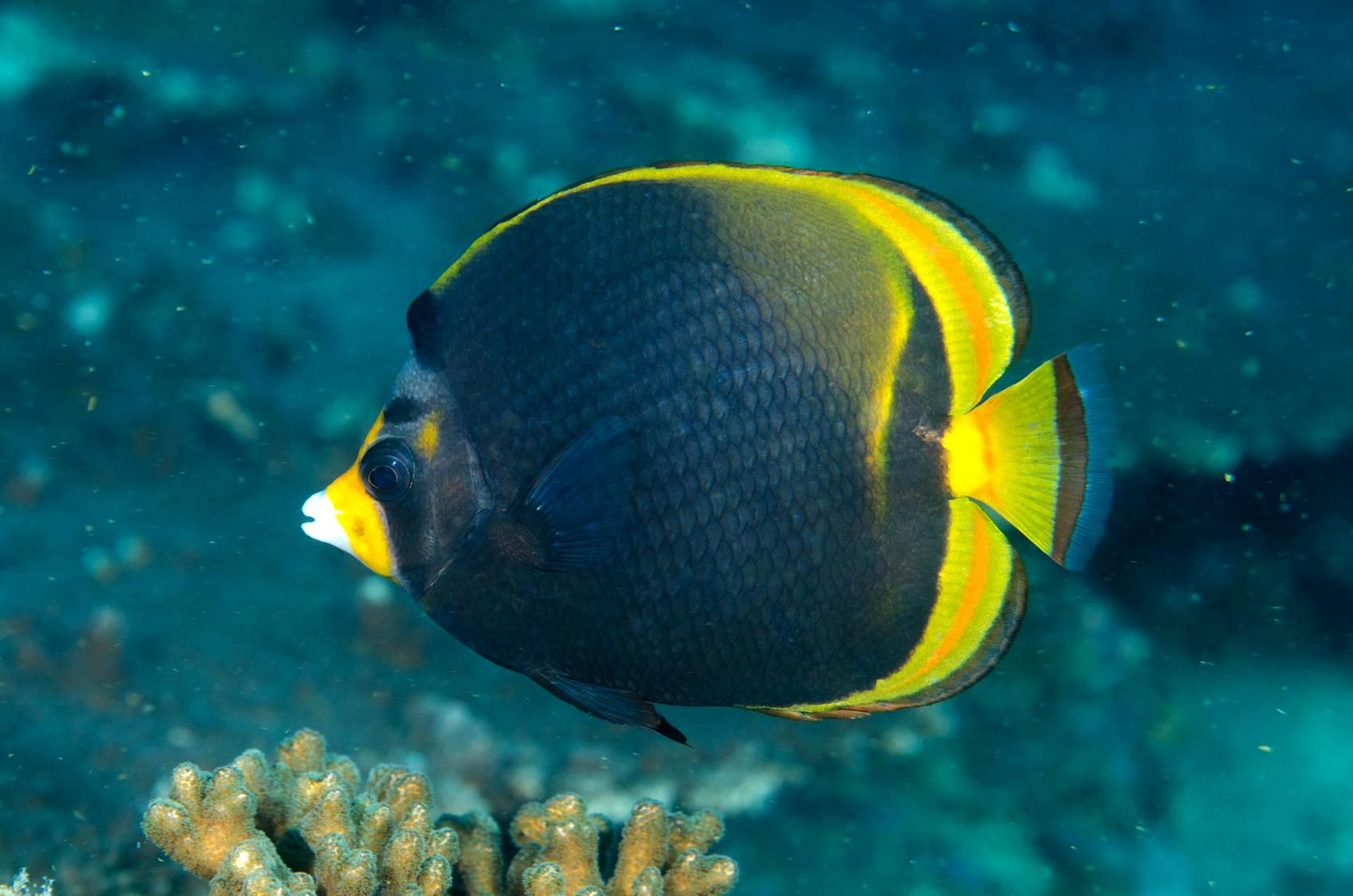- Classification
- ACTINOPTERYGII
- PERCIFORMES
- CHAETODONTIDAE
- Chaetodon
- flavirostris
Dusky Butterflyfish, Chaetodon flavirostris Günther 1874
Other Names: Black Butterflyfish, Dusky Butterfly-fish, Yellow-faced Butterfly-fish

A Dusky Butterflyfish, Chaetodon flavirostris, at North Solitary Island, New South Wales, October 2013. Source: Ian Shaw / iNaturalist.org. License: CC BY Attribution-NonCommercial
Summary:
A purplish-black butterflyfish with broad yellow submarginal bands on the dorsal, caudal and anal fins, a yellowish-orange band around the snout, white lips and a black hump on the forehead.
Cite this page as:
Bray, D.J. & Thompson, A.S. 2023, Chaetodon flavirostris in Fishes of Australia, accessed 03 Jul 2025, https://fishesofaustralia.net.au/Home/species/2381
Dusky Butterflyfish, Chaetodon flavirostris Günther 1874
More Info
|
Distribution |
Northern Great Barrier Reef, Queensland, and reefs in the Coral Sea, to Merimbula, New South Wales; also Cocos (Keeling) Islands in the eastern Indian Ocean, and the Lord Howe Province and Norfolk Island in the Tasman Sea. Elsewhere the species is widespread and abundant in some areas throughout the tropical southwest-central Pacific. Inhabits areas of rich coral growth on outer and more sheltered inner reefs. The species may also be found in estuaries, and on algal-covered rocky reefs. Juveniles prefer protected inner reef areas. |
|
Features |
Dorsal fin XII-XIII,24-27; Anal fin III, 20-21. |
|
Feeding |
Prefers live corals, although individuals occur in areas without live coral. |
|
Remarks |
Although usually seen singly or in pairs, Dusky Butterflyfish may form larger aggregations - e.g. at Lord Howe Island. |
|
Etymology |
The specific name flavirostris is from the Latin flavus (= yellow) and rostris (= snout), in reference to the yellow-orange band that encircles the snout. |
|
Species Citation |
Chaetodon flavirostris Günther, 1874, Fische der Südsee 2(5): 41. Type locality: Tonga (as Vavau, Friendly Islands). |
|
Author |
Bray, D.J. & Thompson, A.S. 2023 |
|
Resources |
Dusky Butterflyfish, Chaetodon flavirostris Günther 1874
References
Allen, G.R., Hoese, D.F., Paxton, J.R., Randall, J.E., Russell, B.C., Starck, W.A., Talbot, F.H. & Whitley, G.P. 1976. Annotated checklist of the fishes of Lord Howe Island. Records of the Australian Museum 30(15): 365-454 figs 1-2
Allen, G.R., Steene, R. & Allen, M. 1998. A Guide to Angelfishes & Butterflyfishes. Cairns : Odyssey Publishing/Tropical Reef Research 250 pp. figs.
Booth, D.J. & Parkinson, K. 2011. Pelagic larval duration is similar across 23° of latitude for two species of butterflyfish (Chaetodontidae) in eastern Australia. Coral Reefs 30: 1071–1075. https://doi.org/10.1007/s00338-011-0815-6
Burgess, W.E. 1978. Butterflyfishes of the World. New Jersey : T.F.H. Publications Inc. 832 pp.
Cole, A.J., Pratchett, M.S. & Jones, G.P. 2008. Diversity and functional importance of coral-feeding fishes on tropical coral reefs. Fish and Fisheries 9: 286-307.
Francis, M. 1993. Checklist of the coastal fishes of Lord Howe, Norfolk, and Kermadec Islands, southwest Pacific Ocean. Pacific Science 47(2): 136-170 figs 1-2
Grant, E.M. 1975. Guide to Fishes. Brisbane : Queensland Government, Co-ordinator General’s Department 640 pp.
Günther, A. 1874. Andrew Garrett's Fische der Südsee. Heft 2. Journal des Museum Godeffroy, Hamburg 2(5): 25-48 pls 21-40
Johnson, J.W. 2010. Fishes of the Moreton Bay Marine Park and adjacent continental shelf waters, Queensland, Australia. pp. 299-353 in Davie, P.J.F. & Phillips, J.A. Proceedings of the Thirteenth International Marine Biological Workshop, The Marine Fauna and Flora of Moreton Bay. Memoirs of the Queensland Museum 54(3)
Kuiter, R.H. 1993. Coastal Fishes of South-eastern Australia. Bathurst : Crawford House Press 437 pp.
Kuiter, R.H. 1996. Guide to Sea Fishes of Australia. A comprehensive reference for divers and fishermen. Sydney, NSW, Australia : New Holland Publishers xvii, 434 pp.
Kuiter, R.H. 2002. Butterflyfishes, Bannerfishes and their Relatives. Chorleywood, U.K. : TMC Publishing 208 pp.
Marshall, T.C. 1964. Fishes of the Great Barrier Reef and Coastal Waters of Queensland. Sydney : Angus & Robertson 566 pp. 136 pls.
Myers, R. & Pratchett, M. 2010. Chaetodon flavirostris. The IUCN Red List of Threatened Species. Version 2015.2.
Ogilby, J.D. 1889. The reptiles and fishes of Lord Howe Island. Memoirs of the Australian Museum 2(3): 51-74 pls 2-3. (as Chaetodon aphrodite)
Oxley, W.G., Ayling, A.M., Cheal, A.J. & Osborne, K. 2004. Marine surveys undertaken in the Elizabeth and Middleton Reefs Marine National Nature Reserve, December 2003. Townsville : Australian Institute of Marine Sciences 64 pp.
Pyle, R. 2001. Chaetodontidae, Pomacanthidae. pp. 3224-3286 in Carpenter, K.E. & Niem, V.H. (eds). The Living Marine Resources of the Western Central Pacific. FAO Species Identification Guide for Fisheries Purposes. Rome : FAO Vol. 5 2791-3379 pp.
Randall, J.E., Allen, G.R. & Steene, R. 1990. Fishes of the Great Barrier Reef and Coral Sea. Bathurst : Crawford House Press 507 pp. figs.
Randall, J.E., Allen, G.R. & Steene, R. 1997. Fishes of the Great Barrier Reef and Coral Sea. Bathurst : Crawford House Press 557 pp. figs.
Steene, R.C. 1978. Butterfly and Angelfishes of the World. Australia. Sydney : A.H. & A.W. Reed Vol. 1 144 pp. 216 figs.











